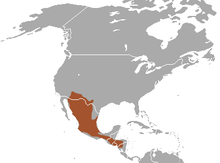Hooded skunk
| Hooded skunk | ||||||||||||
|---|---|---|---|---|---|---|---|---|---|---|---|---|

Haubenskunk ( Mephitis macroura ) |
||||||||||||
| Systematics | ||||||||||||
|
||||||||||||
| Scientific name | ||||||||||||
| Mephitis macroura | ||||||||||||
| Lichtenstein , 1832 |
The hooded skunk ( Mephitis macroura ) is a species of the genus striped skunks from the family of the skunks (Mephitidae) known as "skunks" . It is common in southern North America and Central America.
features
The Haubenskunk is about the size of a cat, but there are large regional differences and the females are about 15% smaller than the males. Males from Costa Rica are about 50% smaller than males from the southern USA. These males reach a maximum total length of 56 to 79 centimeters and a tail length of 27.5 to 43.5 centimeters. The weight is a maximum of around 2.1 kilograms.
The hooded skunk is colored black with a conspicuous drawing on the back, which can be different. The entire back and head can be covered with a wide white stripe, or it can be two narrow, parallel stripes on the back, which as a rule do not converge on the head; almost completely black animals with only a few white hairs in their tails are known. On the nose to the forehead, the hooded skunk has another white stripe, which is also formed in the black form. The head is triangular with small, round ears and black eyes without lids . The tail is long and bushy.
distribution
The distribution area of the crested scunks stretches from the southern United States over Mexico to far into Central America and includes parts of Guatemala , Honduras , Nicaragua and the northwestern Costa Rica .
Systematics
|
Phylogenetic systematics of the Skunks
|
The hooded skunk is classified as an independent species within the genus of the striped skunk ( Mephitis ), which consists of two species. The first scientific description comes from Martin Lichtenstein from 1832 on the basis of an individual from the mountain regions northwest of Mexico City . Within the species, four subspecies are distinguished with the nominate form Mephitis macroura macroura , Mephitis macroura eximius , Mephitis macroura milleri and Mephitis macroura richardsoni .
As a further way within the Streifenskunks and thus as a sister species of the hood skunks was striped skunk ( Mephitis mephitis ) described. The striped skunks as a whole represent the sister group of the spotted skunks ( Spilogals ), which are also widespread in North and Central America , although the ancestors of these two genera separated about 12 million years ago. The Belarusian skunks ( Conepatus ), which are more concentrated on South America, are contrasted with these. Within the strip skunks, radiation to the species known today took place around 3 to 3.5 million years ago.
Hazard and protection
The Haubenskunk is classified by the International Union for Conservation of Nature and Natural Resources (IUCN) as not endangered ("least concern") due to its large distribution area and the relatively frequent occurrence as well as the ability to adapt to different habitats including anthropogenically modified habitats. It is believed that stocks will increase in some regions.
There is no risk to the hooded skunk. In Mexico, the species is very common and also lives in and near human settlements and agricultural areas. Regionally, they are hunted for their meat and fur .
supporting documents
- ^ Yeen Ten Hwang, Serge Larivière: Mephitis macroura . In: Mammalian Species . tape 686 , 2001, p. 1-7 , doi : 10.2307 / 0.686.1 .
- ↑ a b c d Mephitis macroura in the endangered Red List species the IUCN 2008. Posted by: AD Cuarón, F. Reid, K. slipway, 2008. Accessed December 28, 2011th
- ↑ a b c Katrin Nyakatura, Olaf RP Bininda-Emonds: Updating the evolutionary history of Carnivora (Mammalia): a new species-level supertree complete with divergence time estimates. BMC Biology 10, 2012. doi: 10.1186 / 1741-7007-10-12
- ↑ a b c Don E. Wilson & DeeAnn M. Reeder (eds.): Mephitis macroura ( Memento of the original from January 17, 2017 in the Internet Archive ) Info: The archive link was inserted automatically and has not yet been checked. Please check the original and archive link according to the instructions and then remove this notice. in Mammal Species of the World. A Taxonomic and Geographic Reference (3rd ed).
literature
- Ronald M. Nowak: Walker's Mammals of the World . Johns Hopkins University Press, 1999, ISBN 0-8018-5789-9 (English).
- Yeen Ten Hwang, Serge Larivière: Mephitis macroura . In: Mammalian Species . tape 686 , 2001, p. 1–7 ( full text [PDF; 276 kB ]).
Web links
- Mephitis macroura in the endangered Red List species the IUCN 2008. Posted by: AD Cuarón, F. Reid, K. slipway, 2008. Accessed December 28, 2011th
